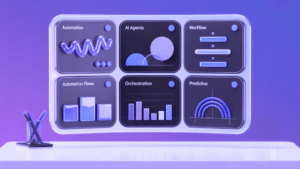Social media platforms are prioritizing conversations over vanity metrics, and the creators who learn how to drive social media conversation will dominate their niches. While likes and follower counts still matter, algorithms now reward meaningful discussion and genuine community interaction.
This shift has been building since 2023, when Meta reported that 40% of Instagram content comes from accounts users don’t follow. This distribution is based entirely on how well content performs with engaged audiences. TikTok’s algorithm gives rewatches 5 points compared to just 1 point for likes. While LinkedIn has clearly moved toward prioritizing thoughtful comments over quick emoji reactions.
If you’re still optimizing purely for likes and follows, you’re missing the bigger opportunity. The creators winning in 2025 know that social media is now about building conversations that drive real business results.
Why the Conversation Shift is Happening?
Social media platforms faced engagement challenges as users spent more time in private messaging apps where real conversations happen. Their solution is to reward public content that recreates that authentic connection.
Here’s what matters now:
- Meaningful comments get significantly more algorithmic boost than simple reactions
- Saves and shares signal content worth keeping, increasing organic reach
- Video completion rates matter more than initial view counts
- Response timing affects distribution—engage quickly to maintain momentum
Platforms make money when people stay engaged. Content that starts conversations keeps people scrolling longer, so algorithms prioritize posts that generate discussion.
Master Platform-Specific Conversation Tactics
Instagram: Turn browsers into participants
Timing goes far beyond sending emails at the right hour. What really matters is understanding when your story becomes urgent andInstagram’s algorithm favors content that drives engagement depth. Reels achieve the highest engagement rates at 2.08%, followed by carousel posts at 1.70% and photo posts at 1.17%. This data from Sprout Social shows that short-form video content and multi-slide carousels naturally invite deeper interaction.
Conversation strategies that work:
- Create Reels that end with questions or calls for user responses
- Use carousel posts to tell stories that build to a conversation starter
- Add Instagram Stories polls and question stickers for immediate dialogue
- Share behind-the-scenes moments in Reels format to maximize reach and questions
- Respond to comments quickly—engagement timing affects algorithmic distribution
Proven framework: Start with an engaging Reel or carousel that provides value, then end with a direct question that relates to your audience’s experience.
TikTok: Design for rewatches and responses
TikTok’s point system values rewatches (5 points) significantly higher than likes (1 point), with comments (2 points) and shares (3 points) also outweighing simple reactions. The platform wants content that people consume multiple times and discuss.
Conversation drivers:
- Hook viewers within the first 3 seconds with movement or unexpected statements
- Include details viewers will notice on second viewing
- End with questions that feel natural to answer in comments
- Use trending sounds while adapting them to spark niche-specific discussion
Real approach: Productivity content creators often end videos with “What’s your version of this?” to generate advice-sharing in comments, creating community discussion beyond the original post.
LinkedIn: Professional conversations that build authority
LinkedIn clearly prioritizes meaningful professional discussion. While specific metrics vary, the platform consistently shows that longer, thoughtful comments receive more distribution than quick reactions or emoji responses.
Authority-building conversation tactics:
- Share industry insights paired with personal lessons learned
- Ask for advice on genuine challenges your professional audience faces
- Engage meaningfully on others’ posts before sharing your own content
- Use native video content which performs significantly better than external links
Effective approach: Marketing professionals find success sharing both wins and failures, asking the community for input on challenges, and facilitating discussions rather than just broadcasting expertise.
Facebook: Community building through groups and connection
Facebook’s algorithm prioritizes content that generates private sharing and meaningful engagement. The platform wants to facilitate the kind of discussions that happen naturally among friends and in communities.
Community engagement strategies:
- Create Facebook Groups around specific problems your audience faces
- Share content designed for private sharing and discussion
- Host live Q&As where you answer questions in real-time
- Use polls and questions that tap into shared experiences
Strategic Conversation Intelligence
Social listening: Understand the conversation landscape
You can’t join conversations effectively without knowing they’re happening. Social listening helps you identify trending topics, monitor sentiment around your industry, and spot opportunities before competitors.
Strategic listening approach:
- Set up alerts for crisis management and immediate response capability
- Monitor sentiment shifts to identify conversation opportunities early
- Track discussions around competitor content to find gaps you can fill
- Use hashtag analysis to join trending conversations authentically
Micro-influencer partnerships for authentic engagement
Research shows 79% of creators prefer long-term partnerships over one-off deals, and micro-influencers consistently achieve higher engagement rates (often 1.73-4%) compared to macro-influencers because their audiences trust their recommendations more.
Partnership strategies:
- Build 6-12 month ambassador programs instead of single sponsored posts
- Allow creative freedom for authentic product integration
- Focus on conversation quality and community building over reach metrics
- Develop collaborative content that unfolds over time
Success factors: The most effective micro-influencer partnerships create ongoing storylines where audiences feel invested in the journey, generating sustained conversation rather than one-time promotional spikes.
User-generated content that drives discussion
UGC works because authentic, unpolished content often outperforms branded content in conversation-focused algorithms. People trust content from other customers more than polished marketing materials.
UGC conversation strategies:
- Create challenges that encourage storytelling, not just product showcasing
- Feature customer problem-solving journeys that invite similar sharing
- Develop hashtag communities around shared experiences
- Ask customers to help other customers through advice-style content
Track Conversations that Actually Matter
Focus on engagement depth over volume
The metrics that predicted success in previous years don’t tell the full story anymore. When algorithms prioritize meaningful interactions, you need to track conversation quality, not just quantity.
Meaningful conversation indicators:
- Response thread depth and back-and-forth exchanges
- Questions asked by audience members showing genuine interest
- Cross-platform conversation continuation
- Private messages and direct responses generated by public content
Conversation completion tracking:
- Content that people reference in their own posts
- Comments that lead to profile visits or follows
- Discussions that generate saves or shares
- Threads where community members help each other
Analytics tools for conversation intelligence
Most social media analytics focus on outdated metrics. Here’s what actually helps track conversation success:
Budget-friendly starter approach:
- Native platform analytics: All major platforms provide free conversation metrics like comment-to-impression ratios, response times, and engagement depth
- Free monitoring tools: Google Alerts and platform notifications help track mentions and conversation opportunities
- UTM tracking: Use Google Analytics to measure how social conversations drive website traffic and conversions
Advanced conversation intelligence:
- Comprehensive platforms: Tools like Sprout Social offer detailed conversation analysis, sentiment tracking, and team collaboration features for managing higher engagement volumes
- Social media management suites: Platforms like Hootsuite provide conversation tracking across multiple accounts and team workflows
Content intelligence tools: Services like BuzzSumo help identify which content types generate the most meaningful conversations in your industry
Crisis Management: When Conversations Turn Challenging
When conversations go negative, your response determines whether you build trust or damage relationships. Effective crisis management means responding authentically and quickly while maintaining transparency.
Crisis response framework:
- Acknowledge quickly: Respond to legitimate concerns within 1-2 hours
- Stay professional: Address issues without becoming defensive
- Take complex discussions private: Offer to continue detailed conversations in DMs
- Follow up publicly: Share resolutions or lessons learned when appropriate
Response templates for common situations:
For legitimate complaints: “Thank you for bringing this to my attention. You’re right that this needs to be addressed. Here’s what I’m doing to fix it: [specific actions]. I’ll update you on progress within [timeframe].”
For misunderstandings: “I can see how my post came across that way, and I should have been clearer. What I meant was [clarification]. Thank you for giving me the opportunity to explain better.”
Crisis monitoring tools:
- Social media management tools with real-time monitoring capabilities
- Google Alerts for your name and brand keywords
- Platform-specific notification settings for mentions and tags
Accessibility in Conversation Design
PuCreating accessible content isn’t just ethical—it’s smart business. Making your content accessible to everyone expands your potential community and often improves engagement for all users.
Conversation accessibility essentials:
- Add descriptive alt text to images for screen readers
- Include captions on videos for deaf and hard-of-hearing users
- Use CamelCase hashtags (#SocialMediaTips vs #socialmediatips) for screen reader compatibility
- Offer multiple ways to engage (comments, DMs, polls, email)
Inclusive conversation practices:
- Ask questions that don’t assume specific experiences or abilities
- Use clear, straightforward language that’s easy to understand
- Provide content in multiple formats when possible
- Create engagement options for different comfort levels
Emerging Trends Shaping Conversations
AI-powered conversation optimization
AI tools can help you understand conversation patterns and optimize timing, but they should enhance authentic engagement, not replace it. Use AI to analyze when your audience is most talkative or identify emerging conversation topics.
Practical AI applications:
- Analyze optimal posting times based on when your audience engages most
- Identify trending topics in your niche before they become mainstream
- Generate conversation starter variations to test what resonates
- Track sentiment changes to spot potential issues early
Voice search and conversational content
With voice search usage growing, content needs to sound natural when spoken aloud. This affects how people discover content and what questions they ask.
Voice-friendly strategies:
- Create content that people naturally want to discuss and share
- Write captions in natural, conversational language
- Include FAQ-style content that answers common spoken questions
- Use longer, conversational keywords in your posts
Building Conversations that Matter
The creators succeeding in 2025 understand that social media algorithms reward authentic human connection. They’re building communities where people feel heard and valued, not just broadcasting to an audience.
Start with one genuine conversation this week. Ask a question you’re actually curious about and respond thoughtfully to every answer. The most successful creators aren’t those with the most followers, but those whose communities actively support each other and engage in meaningful dialogue.
Social media success in 2025 comes from understanding that every comment strengthens relationships, every question teaches you about your audience, and every conversation builds long-term community growth.
Frequently Asked Questions
How do I measure if conversations actually help my business?
Track conversation-to-conversion paths using UTM codes and analytics. Look for patterns: Do people who engage with your content visit your website, sign up for emails, or make purchases? Focus on the customer journey from comment to conversion.
What if my audience doesn’t engage much currently?
Start by engaging authentically with others in your niche. Comment meaningfully on posts from accounts your ideal audience follows. Share more personal stories and be vulnerable—authenticity often sparks connection. Ask simpler questions before moving to complex topics.
How often should I post conversation-focused content?
Quality beats frequency. One post that generates meaningful discussion provides more value than several posts with scattered engagement. Aim for 2-3 conversation-focused posts per week per platform, with other content supporting these main pieces.
Should I delete negative comments?
Only delete spam, harassment, or content that violates platform guidelines. Respond publicly to legitimate criticism—it builds trust with your broader audience. Use negative feedback as an opportunity to demonstrate your values and problem-solving approach.
How do I handle conversations that become too personal?
Set clear community guidelines and maintain them consistently. For overly personal discussions, respond with empathy but guide them to private channels: “This sounds important—let’s continue in DMs where I can give you proper attention.”
What’s the difference between real engagement and artificial tactics?
Real engagement comes from providing genuine value and fostering authentic connections. Avoid engagement pods or buying interactions—algorithms can detect artificial patterns, and fake engagement doesn’t convert to business results. Focus on building relationships with people genuinely interested in your content.
With Media Meter’s real-time brand mention tracking, you’ll always stay ahead by knowing exactly where and how your brand appears in the media. Contact us for inquiries or view our sample media reports to know how we can help you.





